
The Black Forest is a large forested mountain range in the state of Baden-Württemberg in southwest Germany, bounded by the Rhine Valley to the west and south and close to the borders with France and Switzerland. It is the source of the Danube and Neckar rivers.
Breisgau-Hochschwarzwald is a Landkreis (district) in the southwest of Baden-Württemberg, Germany. Fifty towns and municipalities with 133 settlements lie within the district. The district itself belongs to the region of Freiburg with the region of Southern Upper Rhine.
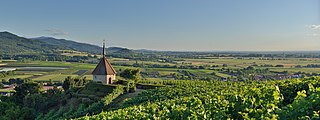
Markgräflerland is a region in the southwest of Germany, in the south of the German federal state of Baden-Württemberg, located between the Breisgau in the north and the Black Forest in the east; adjacent to west with France and in the south with Switzerland.

Bad Peterstal-Griesbach is a municipality in the district of Ortenau in Baden-Württemberg in Germany.

The Herzogenhorn is a mountain, 1,415.2 m above sea level (NHN), in the southwest German state of Baden-Württemberg. It lies within a nature reserve in the municipality of Bernau im Schwarzwald.

The Kniebis is a 970 -metre-high mountain ridge in the Black Forest and the name of a village to the south which is a dispersed settlement. The Kniebis mountain rises in the state of Baden-Württemberg, Germany.
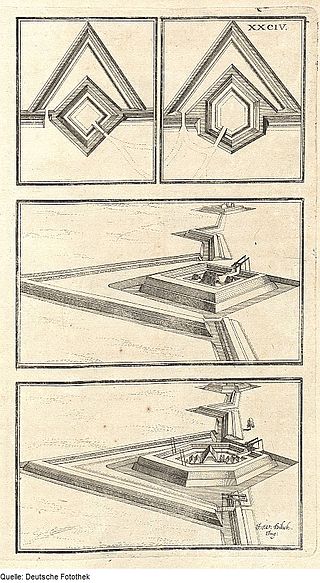
A schanze is, according to the specialist terminology of German fortification construction, an independent fieldwork that is frequently used in the construction of temporary field fortifications. The word is German and has no direct English equivalent, although the word sconce is derived from Dutch schans, which is cognate to the German word.
The Lines of Stollhofen was a line of defensive earthworks built for the Reichsarmee at the start of the War of the Spanish Succession (1701–1714) running for about 15 kilometres (9.3 mi) from Stollhofen on the Rhine to the impenetrable woods on the hills east of Bühl.

The Bonndorf Graben is a southeast-northwest to east-west striking, tectonic graben system on the eastern edge of the Black Forest and in the Baar between Bonndorf im Schwarzwald and Donaueschingen. The upper reaches of the Wutach flow through it. Formed during Variscan mountain building, the graben was reactivated in the Tertiary, when the basement and platform being created.

The Dinkelberg is a partially forested hill range, up to 536.2 m above sea level (NHN), about 145 km2 in area, in the High Rhine region of Germany. It lies within the counties of Lörrach and Waldshut in the German state of Baden-Württemberg and the Swiss canton of Basel-Stadt. It is on the southwestern edge of the

The Hotzenwald is a landscape and region in the Southern Black Forest in the county of Waldshut. Its headquarters was the Waldvogteiamt.
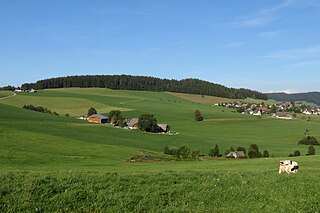
The Roßberg is a mountain, 1,124.7 m above sea level (NHN), in the Black Forest immediately north of Breitnau in the German state of Baden-Württemberg. Hinterzarten, Titisee-Neustadt and St. Märgen are also nearby. On the same ridge just over 1 km to the west is the Hohwart and 2 km to the east, across the Oberbach valley, is the highest mountain in Breitnau municipality: the Weißtannenhöhe.

The Eppingen lines were a fortified defensive line, which stretched from Weißenstein near Pforzheim via Mühlacker, Sternenfels, Eppingen to Neckargemünd in southern Germany. It had a total length of 86 kilometres.

The Hohwart is a mountain near the village of Breitnau in the Black Forest in the German state of Baden-Württemberg. It is 1,123 metres high.

There are numerous prehistorical and early historical ringworks and fortification ramparts in Central Europe that have erroneously, usually colloquially, been given the name Schwedenschanze, which means "Swedish redoubt", a schanze being a hastily erected, military fieldwork.
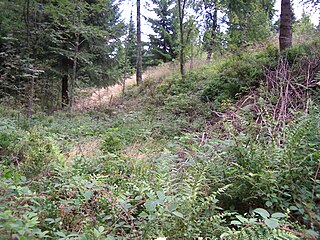
The Schwedenschanze (Zuflucht) is a former schanze in Bad Peterstal-Griesbach in the Black Forest in Southern Germany.
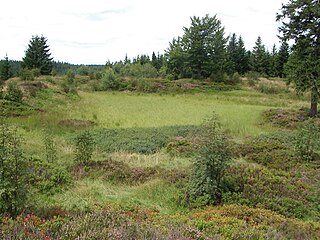
The Röschenschanze is a former schanze in Bad Peterstal-Griesbach in the Black Forest in Southern Germany.
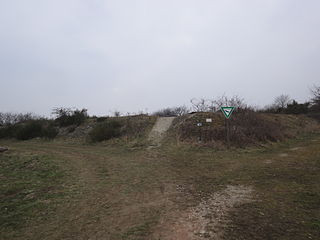
The Schwedenschanze in Dörscheid in the Middle Rhine valley is a Sternschanze or star-shaped fortification that was probably built when the Landgrave of Hesse was besieged by the Palatine Kaub in 1631/32 during the Thirty Years' War.
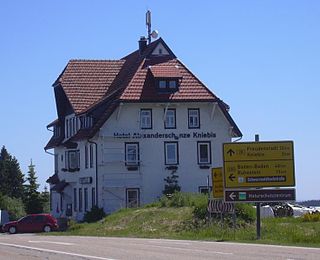
The Alexanderschanze is a mountain pass, 970.8 m above sea level (NHN), on the B 28 federal road at Freudenstadt in the Northern Black Forest in southern Germany. In the vicinity is also a fortification and hotel of the same name.



















